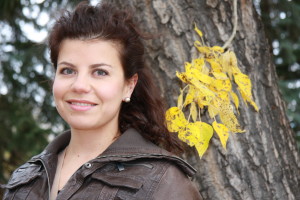In the Spotlight: Jani Krulc

I feel lucky to share Jani Krulc’s work with you in this spotlight. We met in a writing studio at Banff, and I felt lucky to have her in my workshop back then, too. I invite you to luxuriate in the feeling of appreciation, curiosity, and attention that you experience as you read this excerpt. That feeling? It’s what it feels like to be respected as a reader.
That’s because Jani gives you tantalizing clues and images that draw a scene and a world so real, you recognize it – but she trusts you to put these things together to co-create the narrative with her. She presents the world to you in a way you’ve never seen before, so you have to pay close attention, to make sure you catch it all. And your attention is constantly rewarded with bright details like this: “Someone has pierced the tip of her left thumbnail with a sparkling yellow hoop.”
And lines like this: “Nada holds the toy in her palm as it struggles to undulate.” (!)
Clear, unexpected, vibrant - Jani Krulc’s writing shines like cut crystal. Enjoy.

Meet Jani
Jani Krulc has an M.A. in English from Concordia University and a B.A. (Hons) from the University of Calgary. Her first book, a collection of short stories called The Jesus Year, was published in the spring of 2013 by Insomniac Press. Jani is an alumna of the Banff Centre’s Writing with Style program, and the former fiction editor of filling Station magazine. She lives in Calgary with her partner and their animals.
Handwriting or computer?
Handwriting first, computer when I need to organize the story.
Page count or time count?
Time.
First drafts or revision?
Revision, which is new.
Writing solo, writing partner, or writing group?
Solo, although I belong to two writing groups, one that offers edits and one that meets every two weeks to chat, exchange books, and write.
Earplugs/quiet or headphones/music?
Complete silence.
How long have you been writing? How long have you known you wanted to be a writer?
I started pretending to write before I really knew the alphabet – I would sit and scratch at a notepad, telling stories out loud. Once I learned the actual mechanics – spelling, for instance – I started writing stories, and I suppose I’ve just kept going.
How do you make time for your writing practice? How do you handle resistance?
I practice yoga daily, and maintaining that practice has helped me cultivate a writing routine; the ritual of it, the repetition, helps quell anxiety: rolling out a mat, sitting at a desk with a particular notebook. I’ve definitely had my dry spells, though, when writing was torturous. Now, when writing becomes difficult, I just try to play. I “pretend” to write and usually something happens. Also, I read short stories.
Tell us about your experience with Story Is a State of Mind. How it has changed your relationship to writing?
I worked with Sarah at the Banff Centre after signing up for Story is a State of Mind. Practically speaking, I use exercises, especially the list of words that start with a particular letter, to help me get going. I also rewrite by hand now, without consulting previous drafts. On a relationship level – I now trust that the story will reveal itself, as long as I’m open to it and I show up.
Excerpt from Paidakia, by Jani Krulc
This excerpt is from a story I’m working on called Paidakia. I wrote the first version in a creative writing class at the University of Calgary in 2001. I’m returning to it now because these characters won’t leave me alone.
The plastic cacti sway back and forth between the rows of saluting Chinese cats and the laughing miniature Buddhas.
Nada pokes at a cactus; it is pink and wearing a sombrero, sprouting out of a little pot, waving from side to side.
A sales clerk, pushing a cart, points at the shelf.
“They dance quicker in the window,” she says. She is restoring items (a white toilet brush, an assortment of men’s athletic socks) to their rightful places. “They’re solar.” Someone has pierced the tip of her left thumbnail with a sparkling yellow hoop.
“Did that hurt?” Nada smooths an eyebrow. Her own nails are bitten down past the whites. The time she got fake ones, for graduation, the esthetician had to build up resin mounds, upon which she affixed the acrylic claws. That was 15 years ago, and Nada has not had a manicure since.
“You never cut your nails?” The words ZAPO SABO glisten below the cactus’s smiling face, two dots and an upcurved line. Nada holds the toy in her palm as it struggles to undulate, then places it in her basket next to the dozen inkless pens she is purchasing for the society, a non-profit. The office buys all its supplies at the Dollarama: see-through envelopes which must be taped shut, pencil holders that smell of petroleum, flimsy binders whose spines shudder open, never to close again. Nada brings her own from home.
Nada wanders the store, her sharp-toed tan kitten heels clicking the scuffed tiles along the kitchen aisle. Brand name cans line the shelves: beef-stuffed pasta squares in tomato sauce, green peas and corn niblets. Twelve packs of gum hang like unfurled accordions next to scratchy bits of wire. Nada selects a box of blue tums for her mother, who complains of stomach upset, and must be picked up from the clinic after work.
The weekend before, over croissants and dulce lattes, Myrna had sat in Nada’s kitchen nook painting brown squiggly lines on her face with an eyebrow pencil.
“Here,” she had said, pushing fingertips into jowls, sliding the flesh up and back towards her ears. “And here.” She kneaded the skin at her temples, her chin softly falling back into place. “You’re lucky, by the time you need this, they’ll just shine a laser at you.” She pulled her fingers through her hair, widening her eyes. “Just remember, it’s Tuesday. I’ll be woozy.”
“You look like Frida Kahlo,” Nada had said; Myrna had drawn a horizontal line between her eyebrows.
“Who?”
Nada pays for the tums and the cactus, and then for the supplies, keeps both receipts, folding hers into a little square and slipping it into a sleeve of her wallet. She will write STATIONARY on it later and submit it with her taxes come spring.
From outside, the clerk spritzes cleaner on the door, erasing fingerprints, then steps back to let Nada out.
“I bought the cactus,” Nada says, lifting the bag.
Note: These monthly spotlights showcase Mysterious Middle Drafts (MMDs). That means they are somewhere between first drafts and final drafts. This is a challenging stage! Emerging writers bravely share their work-in-progress here for discussion, but this is not a book review or critique: this is a venue for the appreciation of Mysterious Middle Drafts. Thank you for making this writing space safe and supportive.
Discussion:
-
What remains with you after reading Jani's work?
-
Can you articulate what’s working in this excerpt – and more importantly, why it’s working?
-
How is your own writing practice like Jani's? How is it different?
Please leave a comment below. And thank you, Jani!

2 comments
Leave a comment